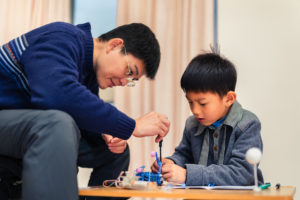September 1, 2023
By Dwight Akerman, OD, MBA, FAAO, FBCLA, FIACLE

Axial myopia has the highest population burden among children and adolescents and is diagnosed when axial length (AL) growth exceeds the loss of refractive power at the cornea and lens. Current studies suggest that visual impairment is more strongly associated with AL than refractive error, and excessive AL growth precipitates vision-threatening complications, including myopic macular degeneration, retinal detachment, and glaucoma. Therefore, AL growth is a good indicator of myopia progression that is detrimental to vision.
A total of 8,546 myopic and treatment-naive Chinese children aged 6–10 years were enrolled from two cohort studies. AL with optical biometer and cycloplegic SE with autorefraction were evaluated at baseline and annually. Annual AL change was calculated, and the percentiles of annual axial elongation among progressive and non-progressive myopes were estimated by quantile regression with restricted cubic spline. Area under receiver-operating characteristic (ROC) curve (AUROC), positive predictive value (PPV), and negative predictive value (NPV) were applied to evaluate the accuracy of predicting progressive and non-progressive myopes.
Among 8,546 myopic children, 603 (7.06%) were non-progressive myopes. Annual AL changes among non-progressive myopes remained stable, with the median annual change being 0.25 mm, while the median for progressive myopes decreased with age from 0.58 to 0.42 mm. AUROC for distinguishing between non-progressive and progressive myopes was 0.88 and was > 0.85 for each age group. Annual AL change, with the cutoff of 0.20 mm/year, had significantly high PPV and NPV in predicting progressive myopes.
Key messages from this article included:
- Non-progressive myopia (annual spherical equivalent [SE] progression ≥ −0.25D) is characterized by more subtle axial length changes that can be compensated by declining lens power. Still, evidence about axial elongation in non-progressive myopes is collected in those using myopia treatment, leaving the amount of AL changes in myopes without treatment unknown.
- Non-progressive myopes had smaller and more stable annual AL changes than progressive myopes.
- AL change of 0.20 mm/year had a high positive predictive value and negative predictive value in predicting progressive and non-progressive myopes. It can be an alternative for evaluating the progressive status and efficacy of myopic treatments.
The authors concluded that annual axial elongation accurately distinguished between progressive and non-progressive myopes. This suggests that annual AL changes may help evaluate myopia progression and the efficacy of myopia treatments in clinical practice. Myopic children with non-progressive status had markedly less axial elongation than progressive ones. AL changes with a cutoff of 0.20 mm/year could differentiate between non-progressive and progressive status and may be an alternative for evaluating progressive status.
Abstract
Axial Length Changes in Progressive and Non‑Progressive Myopic Children in China
Jun Chen, Shang Liu, Zhuoting Zhu, Gabriella Bulloch, Thomas Naduvilath, Jingjing Wang, Linlin Du, Jinliuxing Yang, Bo Zhang, Haidong Zou, Xun Xu, Xiangui He
Purpose: Due to pubertal development and crystalline lens compensation, axial length (AL) continues to increase among non-progressive myopic children (absolute annual spherical equivalent (SE) progression less than 0.25 diopter), but the amount is unknown. This study was to investigate the cutoff of AL change to accurately differentiate between progressive and non-progressive myopes.
Methods: A total of 8,546 myopic and treatment-naive children aged 6–10 years were enrolled from two cohort studies. AL with optical biometer and cycloplegic SE with auto refraction were evaluated at baseline and annually. Annual AL change was calculated, and the percentiles of annual axial elongation among progressive and non-progressive myopes were estimated by quantile regression with restricted cubic spline. Area under receiver-operating characteristic (ROC) curve (AUROC), positive predictive value (PPV), and negative predictive value (NPV) were applied to evaluate the accuracy of predicting progressive and non-progressive myopes.
Results: Among 8,546 myopic children, 603 (7.06%) were non-progressive myopes. Annual AL changes among non-progressive myopes remained stable, with the median annual change being 0.25 mm, while the median for progressive myopes decreased with age from 0.58 to 0.42 mm. AUROC for distinguishing between non-progressive and progressive myopes was 0.88 and was > 0.85 for each age group. Annual AL change, with the cutoff of 0.20 mm/year, had significantly high PPV and NPV in predicting progressive myopes with a high proportion of progressive myopes and non-progressive myopes with low proportions of progressive myopes.
Conclusion: Myopic children with non-progressive status had markedly less axial elongation than progressive ones. AL changes with a 0.20 mm/year cutoff could differentiate between non-progressive and progressive status and may be an alternative for evaluating progressive status.
Chen, J., Liu, S., Zhu, Z., Bulloch, G., Naduvilath, T., Wang, J., … & He, X. (2023). Axial length changes in progressive and non-progressive myopic children in China. Graefe’s Archive for Clinical and Experimental Ophthalmology, 261(5), 1493-1501.
DOI: https://doi.org/10.1007/s00417-022-05901-5













